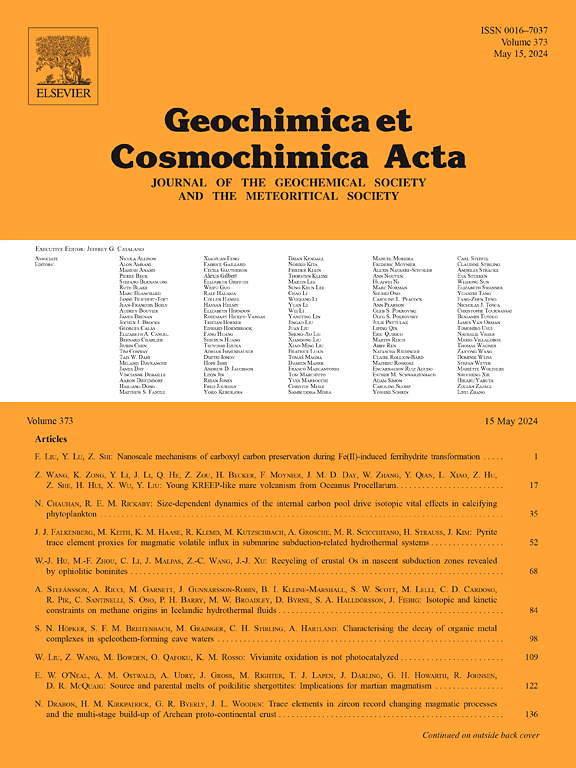Self-induced differential stress and cascading reactions, fracturing, and permeability enhancement triggered by volatile-consuming reactions
IF 5
1区 地球科学
Q1 GEOCHEMISTRY & GEOPHYSICS
引用次数: 0
Abstract
Reaction-induced fracturing is thought to be a key process controlling pervasive volatile-consuming reactions, including the serpentinization and carbonation of peridotites; however, the interactions between reactions, fluid flow, and fracturing remain poorly understood. We performed flow-through hydration experiments on sintered periclase aggregate [MgO + H2O → Mg(OH)2] samples with high and low porosities at temperatures of 180–200 °C, confining pressure of 20 MPa, and fluid pressures of 3–5 MPa. We monitored the solid volume, permeability, and axial stress simultaneously. For comparison, we also conducted batch experiments with the same samples. In the batch experiments, the high-porosity sample reacted uniformly with no macroscopic fracturing, whereas a sharp reaction front developed in the low-porosity sample. In the flow-through experiments with high-porosity samples, the reaction proceeded uniformly, with an initial decrease in permeability but no increase in volume. Axial stress then increased, and the sample subsequently yielded gradually. The reaction continued, causing circumferential expansion of the sample with no discrete failure while the permeability remained constant or increased. In the flow-through experiments with low-porosity samples, the reaction began slowly through surface layer spallation. After a prolonged initiation period, mechanical instability led to a sudden large failure. This failure triggered cascading reactions, with a build-up of reaction-induced stress followed by yielding and the formation of new fractures, resulting in the permeability increasing by two orders of magnitude and leading to reaction rates increasing by a factor of 18 compared with the batch experiments. The results suggest that (1) reaction-induced fracturing is strongly enhanced by self-induced differential stress related to the anisotropic elastic properties of the lithosphere, and (2) catastrophic failure can occur during the hydration and carbonation of impermeable mantle peridotite. These findings provide new links between microscopic failure at reaction interfaces and macroscopic fractures in a rock, and have implications for the pervasive serpentinization of the oceanic lithosphere, the formation of serpentine diapirs, and natural and anthropogenic CO2 sequestration.
自诱导的差应力和级联反应、压裂以及挥发性消耗反应引发的渗透率提高
反应诱导压裂被认为是控制普遍挥发性消耗反应的关键过程,包括橄榄岩的蛇纹石化和碳酸化;然而,人们对反应、流体流动和压裂之间的相互作用仍然知之甚少。在温度为180 ~ 200 °C、围压为20 MPa、流体压力为3 ~ 5 MPa的条件下,对高孔隙率和低孔隙率的烧结方石骨料[MgO + H2O → Mg(OH)2]试样进行了流动水化实验。我们同时监测了固体体积、渗透率和轴向应力。为了比较,我们还对相同的样品进行了批量实验。在批量实验中,高孔隙度试样反应均匀,无宏观裂缝,而低孔隙度试样则出现了尖锐的反应锋。在高孔隙度样品的渗流实验中,反应进行均匀,初始渗透率降低,但体积没有增加。轴向应力逐渐增大,试样逐渐屈服。反应继续进行,在渗透率保持不变或增加的情况下,导致样品的周向膨胀而没有离散破坏。在低孔隙率样品的渗流实验中,反应通过表面层剥落缓慢开始。经过长时间的启动期,机械不稳定导致突然的大故障。这种破坏引发了级联反应,反应引起的应力积聚,随后屈服并形成新的裂缝,导致渗透率增加了两个数量级,导致反应速率比批量实验增加了18倍。结果表明:(1)与岩石圈各向异性弹性特性相关的自致差应力对反应致裂作用增强;(2)不透水地幔橄榄岩在水化碳酸化过程中可能发生灾难性破坏。这些发现为反应界面的微观破坏与岩石的宏观裂缝之间提供了新的联系,并对海洋岩石圈普遍的蛇纹石化、蛇纹石底辟的形成以及自然和人为的二氧化碳封存具有重要意义。
本文章由计算机程序翻译,如有差异,请以英文原文为准。
求助全文
约1分钟内获得全文
求助全文
来源期刊

Geochimica et Cosmochimica Acta
地学-地球化学与地球物理
CiteScore
9.60
自引率
14.00%
发文量
437
审稿时长
6 months
期刊介绍:
Geochimica et Cosmochimica Acta publishes research papers in a wide range of subjects in terrestrial geochemistry, meteoritics, and planetary geochemistry. The scope of the journal includes:
1). Physical chemistry of gases, aqueous solutions, glasses, and crystalline solids
2). Igneous and metamorphic petrology
3). Chemical processes in the atmosphere, hydrosphere, biosphere, and lithosphere of the Earth
4). Organic geochemistry
5). Isotope geochemistry
6). Meteoritics and meteorite impacts
7). Lunar science; and
8). Planetary geochemistry.
 求助内容:
求助内容: 应助结果提醒方式:
应助结果提醒方式:


